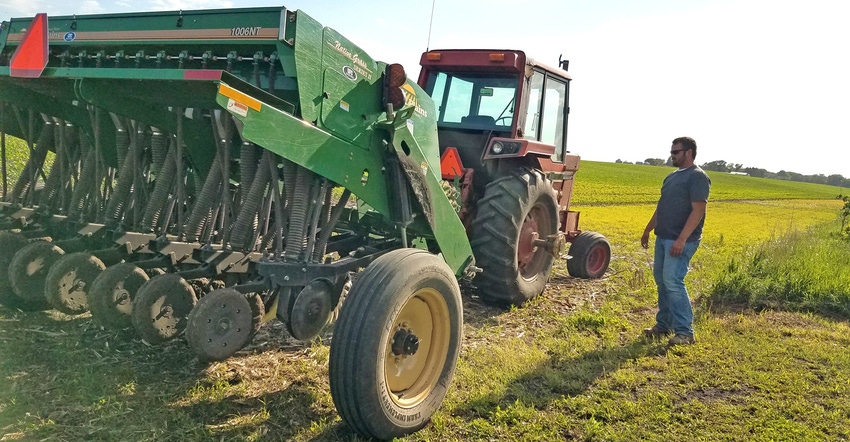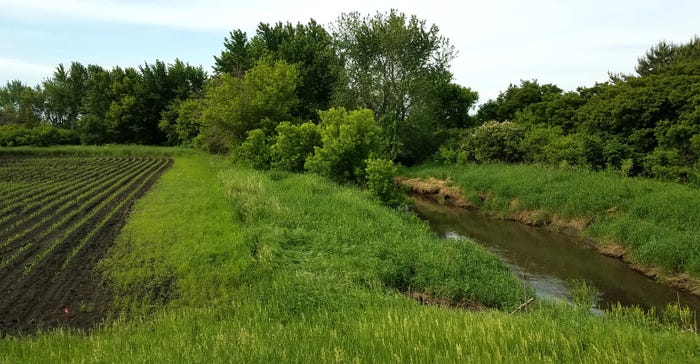July 20, 2021

Watonwan County recently became the 29th Minnesota county to bring 100% of applicable land into compliance with Minnesota’s riparian buffer law.
The law requires perennial vegetative buffers of up to 50 feet along lakes, rivers and streams, and of 16.5 feet along ditches. Riparian buffers help filter out phosphorus, nitrogen and sediment, and are an important conservation practice for helping to keep water clean. The Minnesota Board of Water and Soil Resources oversees compliance in partnership with local governments.
 CONSERVATION OPTIONS: Alternative practices such as the USDA Natural Resources Conservation Service 393 filter strips were used to bring the majority of applicable land in Watonwan County into compliance with the state's riparian buffer law.
CONSERVATION OPTIONS: Alternative practices such as the USDA Natural Resources Conservation Service 393 filter strips were used to bring the majority of applicable land in Watonwan County into compliance with the state's riparian buffer law.

Watonwan County faced unique challenges when the Minnesota Legislature passed the law in 2015. Watonwan Soil and Water Conservation District staff estimated buffer compliance at 44% countywide in 2015, the 12th-lowest compliance rate in the state at the time. Approximately 1,128 parcels located adjacent to public waters needed to be brought into compliance by Nov. 1, 2017; an additional 142 parcels located adjacent to public ditches needed to become compliant by Nov. 1, 2018.
Watonwan County hired Chad Hildebrand in February 2016 to spearhead buffer compliance efforts for the SWCD. After working as a district technician for four years with a focus on buffer compliance, he was promoted to SWCD assistant manager and county ditch inspector in 2020. Hildebrand took a job with Goodhue SWCD in April.
“Putting a face to the SWCD helped me build relationships with township officials and landowners,” Hildebrand says. “It’s about listening — listening to their concerns, and trying to find the best route to take to meet statute and meet their goals.”
In 2017, Watonwan County opted to have BWSR handle its buffer enforcement. Hildebrand says this decision helped landowners view the SWCD as a resource for voluntary conservation rather than a regulatory entity. The distinction helped build trust between SWCD staff and landowners, he adds.
A tough sell
The 2012 USDA Census of Agriculture indicates that 94% of farmland in Watonwan County is used for growing crops. Hildebrand says getting farmers to give up productive cropland to put in buffers was a tough sell, so he frequently presented landowners with alternative practice options.
Alternative practices produce water quality benefits comparable to a full-width buffer and typically take up a smaller footprint. BWSR developed a suite of common alternative practices including filter strips, grassed waterways and participation in the Minnesota Department of Agriculture’s Minnesota Agricultural Water Quality Certification Program, which aims to improve water quality with a whole-farm approach.
In addition to these common alternative practices, landowners can work with their SWCD office to see what options may fit their land and operation while still meeting statutory requirements.
According to BWSR buffer and soil loss specialist Kevin Roth, 78% of out-of-compliance parcels in Watonwan County were brought into compliance via alternative practices.
“There’s a lot more flexibility with alternative practices,” Hildebrand says. “I’d give landowners many different options and advise them to take the option that best fits their operation today and will continue to fit it five to 10 years down the road.”
Hildebrand reached out to landowners by regularly attending and speaking at township meetings, sending postcards and conducting site visits. The SWCD used capacity funding allocated by BWSR to purchase a no-till drill in 2016, which Hildebrand frequently delivered to farms throughout the county to help residents reach compliance with the buffer law. Hildebrand estimates farmers throughout the county seeded about 1,500 acres of buffers using the SWCD-owned, no-till drill.
According to Hildebrand, achieving compliance involved many late nights and challenging conversations. The final parcel was brought into compliance in May.
“It was a long process, but once we built trust, we were able to hit the ground running,” Hildebrand says.
Source: BWSR, which is solely responsible for the information provided and is wholly owned by the source. Informa Business Media and all of its subsidiaries are not responsible for any of the content contained in this information asset.
You May Also Like




